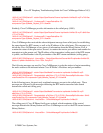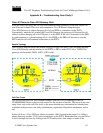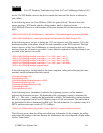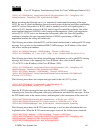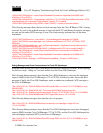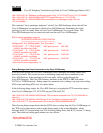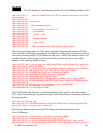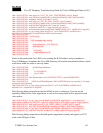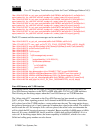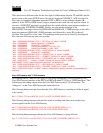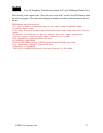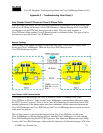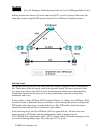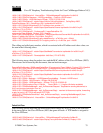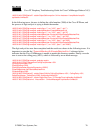
Cisco IP Telephony Troubleshooting Guide for Cisco CallManager Release 3.0(1)
© 2000 Cisco Systems, Inc. 70
*Mar 12 04:03:57.653: cc_api_caps_ack (dstVdbPtr=0x617BE064, dstCallId=0x12, srcCallId=0x11,
caps={codec=0x1, fax_rate=0x2, vad=0x2, modem=0x1, codec_bytes=160, signal_type=0})
*Mar 12 04:03:57.653: cc_api_caps_ind (dstVdbPtr=0x617BE064, dstCallId=0x12, srcCallId=0x11,
caps={codec=0x1, fax_rate=0x2, vad=0x2, modem=0x, codec_bytes=160, signal_type=0})
*Mar 12 04:03:57.653: cc_api_caps_ack (dstVdbPtr=0x617BE064, dstCallId=0x12, srcCallId=0x11,
caps={codec=0x1, fax_rate=0x2, vad=0x2, modem=0x1, codec_bytes=160, signal_type=0})
*Mar 12 04:03:57.657: cc_api_caps_ack (dstVdbPtr=0x616C9F54, dstCallId=0x11, srcCallId=0x12,
caps={codec=0x1, fax_rate=0x2, vad=0x2, modem=0x1, codec_bytes=160, signal_type=0})
*Mar 12 04:03:57.657: cc_api_caps_ack (dstVdbPtr=0x616C9F54, dstCallId=0x11, srcCallId=0x12,
caps={codec=0x1, fax_rate=0x2, vad=0x2, modem=0x1, codec_bytes=160, signal_type=0})
The H.323 connect and disconnect messages can be seen below.
*Mar 12 04:03:59.373: cc_api_call_connected(vdbPtr=0x617BE064, callID=0x12)
*Mar 12 04:03:59.373: sess_appl: ev(8=CC_EV_CALL_CONNECTED), cid(18), disp(0)
*Mar 12 04:03:59.373: ssa: cid(18)st(4)oldst(1)cfid(7)csize(0)in(0)fDest(0)-cid2(17)st2(4)oldst2(3)
*Mar 12 04:03:59.373: ccCallConnect (callID=0x11)
*Mar 12 04:03:59.373: {
*Mar 12 04:03:59.373: h323-uu-pdu
*Mar 12 04:03:59.373: {
*Mar 12 04:03:59.373: h323-message-body connect :
*Mar 12 04:03:59.373: {
*Mar 12 04:03:59.373: protocolIdentifier { 0 0 8 2250 0 2 },
*Mar 12 04:03:59.373: h245Address ipAddress :
*Mar 12 04:03:59.373: {
*Mar 12 04:03:59.377: ip ’AC1046E2’H,
*Mar 12 04:03:59.377: port 011008
*Mar 12 04:03:59.377: },
*Mar 12 04:03:59.389: Hex representation of the CONNECT TPKT to send.03000052080
*Mar 12 04:03:59.393: H225Lib::h225SetupResponse: Q.931 CONNECT sent from socket [1]
*Mar 12 04:03:59.393: H225Lib::h225SetupResponse: Q.931 Call State changed to [Active].
*Mar 12 04:04:08.769: cc_api_call_disconnected(vdbPtr=0x617BE064, callID=0x12, cause=0x10)
*Mar 12 04:04:08.769: sess_appl: ev(12=CC_EV_CALL_DISCONNECTED), cid(18), disp(0)
Cisco IOS Gateway with T1/PRI Interface
As explained earlier, there are two types of calls going through the Cisco IOS Gateways: the
Cisco IOS Gateway interfaces to the PSTN or PBX with either T1/CAS or T1/PRI interfaces.
The following are the debug outputs when the Cisco IOS Gateways use T1/PRI interface.
The “debug isdn q931” command on the Cisco IOS Gateway has been turned on, enabling
Q.931, a Layer Three signaling protocol for D-channel in the ISDN environment. Each time a
call is placed out of the T1/PRI interface, a setup packet must be sent. The setup packet always
has (protocol descriptor) pd = 8 and it generates a random hex value for the callref. The callref is
used to track the call. For example, if two calls are placed, the callref value can determine the
call for which the RX (received) message is intended. Bearer capability 0x8890 means a 64kb/s
data call. If it were a 0x8890218F, then it would be a 56kb/s data call and 0x8090A3 if it is a
voice call. In the debug output below, the bearer capability is 0x8090A3, which is for voice.
Called and calling party numbers are also shown.



